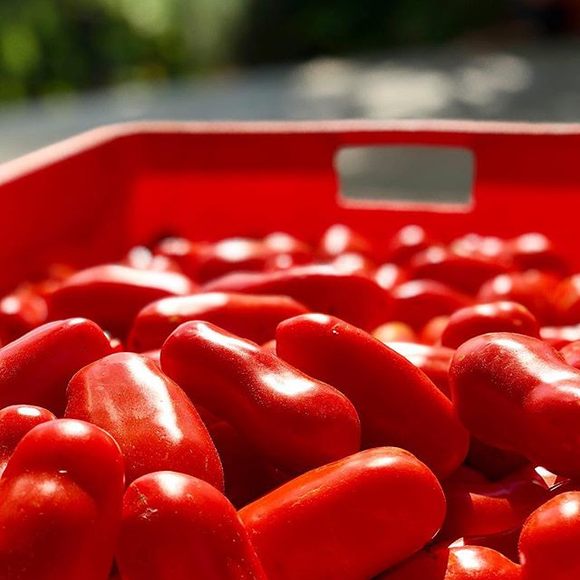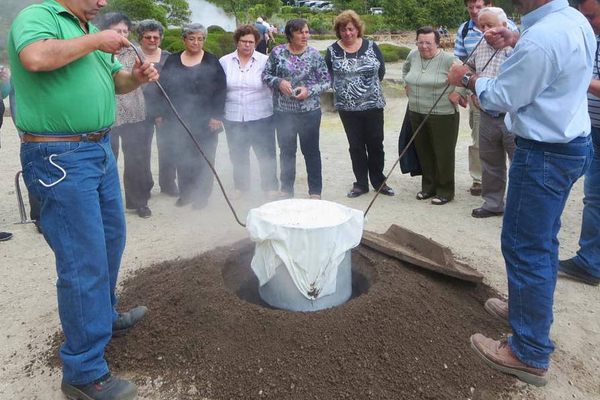Fruits & Vegetables
San Marzano Tomatoes
Grown in the volcanic soil around Mt. Vesuvius, these tomatoes are one of only a couple varieties used in authentic Neapolitan pizza.
On March 17, 1944, ash belched from the center of the Earth. It sputtered up in great gusts through Mt. Vesuvius, clouding the air and sending the people of the surrounding villages running for shelter. Lava streamed down the volcano’s sides. In the midst of a cataclysmic World War, Vesuvius’s eruption—the worst in 72 years—was just one more egregious disaster. But there was one living thing the explosion was good for: Campania’s tomatoes.
They’re called pomodori di San Marzano, after the Italian word for the yellow tomatoes first imported to Italy from the Americas, pomo di oro, or “golden apples.” They thrive in the rich volcanic soils of the Sarno River Valley in Southwest Italy’s Campania, near the city of San Marzano, where their signature oblong shapes grow from rows of low vines. Rich-fleshed, thin-skinned, and sweet, with sparing seeds and little acidity, thanks to the volcanic soil high in potassium and phosphorous, San Marzano tomatoes are prized throughout the world. Their status isn’t just due to where they grow. Campania is the Southwest Italian region that also houses the city of Naples. And Naples, of course, is the home of one of the world’s most famed culinary legacies: Neapolitan pizza. For the pizzaioli or pizza makers of the Associazione Vera Pizza Napoletana, the True Neapolitan Pizza Association, San Marzano tomatoes are one of only a few varieties that will do in a proper Neapolitan pie.
Over the years, these rare, blushing darlings have gained quite a mythology. According to one myth, in 1770, the Viceroyalty of Peru sent the first San Marzano seeds as a gift to the King of Naples. While this likely isn’t true, it is true that Europeans regarded the first tomatoes to make the transatlantic trip with widespread suspicion, believing them to be poisonous (a sensible assumption, considering the plants are related to deadly nightshade). That wariness soon wore off, however, and today pomodori di San Marzano are protected by an official Protected Designation of Origin certification, meaning strict geographical and production standards govern what can be properly called a San Marzano tomato.
Tomatoes given this certification must not only be of the San Marzano variety, they must be grown in the volcanic soil of the Sarno valley. While the authentic variety are available in supermarkets and Italian specialty stores around the world, the best way to experience a San Marzano is in Campania itself. Unlike typical supermarket tomatoes, which are picked green and ripened in warehouses, pomodori di San Marzano are picked under the setting sun in September when they’re red and skin-splittingly ripe. Try one fresh from a market table, still sun-warm, and you too will know why Italians originally referred to tomatoes as gold.
Where to Try It
-
Gustarosso Website
Via Ingegno, Sarno, 84087 , ItalyGustarosso is the brand associated with an agricultural co-op that produces and exports San Marzano tomatoes. Their guesthouse in Sarno offers a pizzeria, cooking lessons, and tours, with all the tomato-related joy money can buy.
Written By
 Reina Gattuso
Reina Gattuso
Sources
- www.walksofitaly.com/blog/food-and-wine/dop-foods-from-italy
- italoamericano.org/story/2016-6-22/sanmarzano-tomatoe
- www.smithsonianmag.com/arts-culture/why-the-tomato-was-feared-in-europe-for-more-than-200-years-863735/
- www.npr.org/2011/08/26/139972669/the-unsavory-story-of-industrially-grown-tomatoes



















